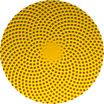On Feb. 18 at the annual meeting of the American Association for the Advancement of Science, Benjamin Greenberg, M.D., a psychiatrist at Brown University and at Butler Hospital, will discuss the longest-term results so far of the technique he's helped pioneer during the last decade. Encouraged as he is with the progress, Greenberg will address how to best apply it, and how basic and clinical researchers are working to understand the changes in brain networks and behaviors that occur when patients improve.
"These techniques are promising but must be used with an abundance of caution," said Greenberg, associate professor of psychiatry and human behavior at the Warren Alpert Medical School of Brown University and chief of outpatient services at Butler Hospital. "This is reserved for the small proportion of people who are severely disabled and have not benefitted anywhere near adequately from very aggressive use of conventional treatments."
Just over 50 patients have had DBS for OCD in the United States since the work began in 2000. The procedure involves surgically placing electrodes just over a millimeter thick into the brain's ventral capsule and nearby ventral striatum, which contain fibers carrying signals between the thalamus, parts of prefrontal cortex, and other nodes in a network thought important in OCD and related neuropsychiatric illnesses. While DBS's mechanism of action remains unknown, Greenberg said, he and collaborators from many disciplines are making progress in understanding the anatomy, physiology, and behavioral changes underpinning DBS for OCD.
Although OCD affects about 1 percent of the adult population in a given year, only a small subset of patients might be eligible for DBS. To qualify, they must have very severe and chronically disabling illness despite at least five years of aggressive treatment by experts.
The FDA's humanitarian device exemption is meant to allow the use of a promising technology in patient populations that are so small (less than 4,000 patients yearly) that the manufacturer might not otherwise recoup the development cost if it had to run extensive trials. In a recent paper, some researchers have questioned whether granting the exemption for DBS for OCD was appropriate because the potential patient population was too large.
But Greenberg said he disagrees. He noted that only about 15 patients nationally have received DBS in each of the last two years despite extensive outreach to clinicians for his current National Institute of Mental Health-funded DBS clinical trial, and the separate humanitarian device exemption approval.
"In the real world, the group of patients meeting appropriate selection criteria is truly small," he said.
Taking the edge off
In 2008, Greenberg and colleagues at three other test sites — Leuven, Belgium, The Cleveland Clinic, and University of Florida — and at Medtronic, the device company that makes the electrodes, published results in the journal Molecular Psychiatry from 26 severely afflicted patients who had been carrying the implant for as long as three years. Using the Yale-Brown Obsessive Compulsive Scale as their main benchmark, they found that 73 percent of patients showed at least a 25-percent reduction in their score.
The newest results, presented in Greenberg's AAAS talk, show that the patients who improve initially and continue to receive stimulation generally remain improved for eight or more years of followup.
DBS might be righting an imbalance in patients between avoiding situations and goal-directed activity, or it might be that DBS bolsters an OCD sufferer's ability to learn that feared situations are safe. Both these changes could help severely afflicted and otherwise treatment-intractable patients better endure the difficulties presented by their illness and the work of undergoing conventional behavior therapy, which Greenberg noted is generally the treatment of choice for OCD.
"What DBS really does is make you into an average OCD patient," Greenberg said.
But the difference between being an extreme OCD patient and an average one, Greenberg said, is the difference between being nearly unable to function in society and being able to integrate into more a normal life. Even after the surgery, that's still a challenge for severe OCD patients. The onset of the disease is usually in the preteen years, so even when their symptoms improve, patients may still face the problem of catching up in education and socialization.
There are other challenges, too. Patients must either undergo repeated surgeries to replace batteries or continuously maintain a rechargeable battery pack. Especially in the early days of this research when higher levels of current were used, some patients suffered side effects including excessive behavioral activation, or hypomania.
When the stimulation stopped, whether due to battery depletion, a broken stimulating wire, or device shutoff from a metal detector, return of pre-DBS depression, anxiety, and OCD symptoms occurred. (That symptoms return when DBS is interrupted and neither patients nor their study doctors know that stimulation has stopped is good evidence that symptom improvements are in fact due to DBS, Greenberg noted.)
Greenberg said that psychiatrists using the technique need to keep a close eye on patients, who should continue receiving ongoing therapy and support after the procedure. Greenberg's treatment center at Butler Hospital includes a full-time clinical nurse who is available around the clock and other psychiatrists who can be called upon as needed.
In all, Greenberg said, the potential complications are very similar to those observed among the tens of thousands of patients who have undergone DBS treatment for Parkinson's Disease. He and colleagues have observed no clinically important new kinds of side effects not already seen in such movement disorder patients.
Greenberg also noted that OCD patients selected for this study have an excellent understanding of the risks, burdens, and potential benefits of DBS.
"They clearly know exactly what they're signing up for," he said. It was not unusual for patients to have read his scientific papers on DBS, he added, and all have scored perfectly on a test of comprehension of study details after informed consent.
"This was no surprise, really, but it highlights the fact that these OCD sufferers are no more vulnerable to misunderstanding when confronted by a complex study design than anybody else," Greenberg said. "In fact, they might actually be better at this than other patient groups."
Brain circuit insights
For all the help the treatment seems to give the most chronically suffering patients, a second outcome of the work may be even more valuable in the long term, Greenberg said. Researchers are gaining a better fundamental understanding of the physiology of OCD and related illnesses.
Greenberg is the co-primary investigator at the Conte Research Center for OCD, based at the University of Rochester, where researchers, including Brown neuroscience chair Barry Connors, have begun six projects that use DBS to tease out the specific brain circuitry underlying the disease.
"We've learned that our conception of the brain circuitry that's involved in OCD and in depression and other illnesses can be tested directly, and that we are on the right track with the anatomical models we are creating for this circuitry," said Greenberg.
As a result, future therapies might be even more precise and effective, giving even greater hope to patients for whom peace of mind is so tragically elusive.
INFORMATION:
For nearly four years, the research at Brown and Butler, including work at the Conte Center, has been funded exclusively by the NIMH. NARSAD and Medtronic provided funding for the pilot clinical work. Greenberg received a past honorarium from Medtronic, for which he has also consulted, with proceeds paid to Butler Hospital.
END

